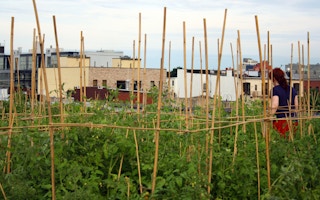The earth is in a bit of a pickle (pun intended). According to the World Bank, we will need to produce 50 per cent more food to feed 9 billion mouths on the planet by 2050. Couple this reality with the bullying blow of climate change on the head of traditional forms of agriculture, and panic has begun to set in faster than you can say “severe acute malnutrition”.
But here’s an idea. What if a big problem like world hunger could be resolved, not through the minds and money of the Fortune 500 elite, but through the collective contribution of ordinary citizens simply taking responsibility for their own backyard? What if the key to this colossal problem lies not in thinking big, but in actually thinking small (albeit on a big scale)?
With growing human populations adding significant pressure to limited arable land throughout the world, people in the city are finding fresh ways to transform their concrete spaces into green opportunities. One small, ingenious act at a time, the urban landscape is offering sustainable alternatives to meet the rising tide of our global appetites.
Professor Ian Harper, leading economist and director of Deloitte Access Economics, recently told a captivated audience at the Design as Strategy Forum at UTS Sydney that we are moving from the economics of mass production into the new world economics of mass agglomeration. Harper had the audience transfixed as he postulated that myriad resources can group together from around the world to provide new services, and mini factories with 3D printers located close to their markets can beat mega factories’ mass production half a world away.
If leading economists believe that this is the future of economic success in the industrial world, couldn’t the same theories be applied to solving the imminent world food shortage problem?
What if bigger is no longer better? Could smaller and smarter mechanisms solve difficult challenges and outweigh size?
In the case of solving a big-scale crisis of world hunger, the solution must be a sum total of the individual parts.
Is there more to urban farming than fad?
Urban agriculture is practised by 800 million people worldwide – representing an incredible 15 to 20 per cent of the world’s food source – and an area of just one square metre can provide 20kg of food annually. As the world’s population rushes towards 9 billion, with 65 per cent of this population in cities over the next few decades, the potency of a veggie garden in every household holds huge implications. If more city dwellers were to feed off the toil of their own soiled hands, a great deal more of the world’s food could be grown by ordinary citizens.
Urban agriculture can also open up new streams of redevelopment and investment, as well as a general rise in consciousness around healthy living. Although land remediation may be required, there are a number of cases where areas of the city once written off as defunct and derelict, are currently being redefined as blank canvases for agricultural innovation. Abandoned factories and warehouses have been repurposed into successful community garden ventures that build collective morale, as well as healthy lifestyle choices.
Rooftop gardens, aquaculture and greenhouses are an ever-increasing ‘good idea’. There is an expensive price tag attached to produce that comes from the farm, and it requires an intensive harvesting and delivery process. Growing products locally eliminates those logistical hoops and hefty markups.
The potential for a ripple effect
But abandoned buildings and back alleys are not the only urban hubs of green innovation. Major international airports are also catching on to the idea by opening their terminals to greenscapes and gardens. Look no further than JetBlue’s veggie patch at Terminal 5 of New York’s JFK Airport. The garden’s beauty not only lifts a weary traveller’s spirits; its many herbs and vegetables furnish the local restaurants and supply the local food banks with healthy greens.
The exciting question is what if this concept went viral? If the eggplant of an ‘airport garden’ became as ubiquitous as the macchiato of a Starbucks cafe, the spin-off effect of social responsibility around the world would be exponential. The relatively empty space of an airport terminal could be used, with minimal effort, to add brand new solutions to human need.
“
What if a big problem like world hunger could be resolved, not through the minds and money of the Fortune 500 elite, but through the collective contribution of ordinary citizens simply taking responsibility for their own backyard?
Urban FarmingTM is an organisation backed by a similar vision. They work hand-in-hand with local people around the world, teaching them how to build gardens in inventive spaces while envisioning them towards sustainable living. Their produce feeds the communities and spills over to local food banks. They’ve also seen these gardens kick-start business growth, job creation, urban redevelopment and global investment – all very good things for communities desperately in need of an economic boost.
Altogether, the organisation has given a healthy model of environmental, business and social solutions to a compounding global conundrum, and enabled thousands to join the urban farming global food chain.
Similarly inspiring, One Central Park in Sydney, designed by Pritzker prize-winning architect Jean Nouvel, is a good example of a building design which embraces greenery. The public park at the heart of the precinct ‘climbs the side of the floor-to-ceiling glass towers to form a lush 21st century canopy’, while ‘vines and leafy foliage spring out between floors and provide the perfect frame for Sydney’s skyline’. In addition, motorised mirrors capture sunlight and direct the rays down onto Central Park’s gardens. After dark, the structure is a canvas for leading light artist Yann Kersalé’s LED art installation, resulting in starlit architecture.
Good news for those without green thumbs
The global march towards urbanisation, compounded by the limp of limited resources, has left in its wake the threat of malnourishment. Considering that much of our arable land is taken and many urban settlements are unsuitable to grow food, people are looking to hydroponics as a viable alternative, as the Dutch have for decades.
This highly controlled method allows for vegetables to be grown in a self-contained environment under optimum conditions. Hydroponics is ideal for crowded city spaces and very effective – rendering good results for even those with ‘black’ thumbs and very little gardening experience.
Several countries have implemented Simplified Hydroponics (SH) – a cost-effective technique, pioneered in South America that uses simple resources available to the community for producing vegetables. With a minimal carbon footprint, SH may well be the solution to maximising inner city crops in developing economies.
An integrated approach
We find ourselves standing at a precipice today. Do we continue on our current path of traditional large-scale farming, or do we endorse the developing web of small-scale urban farming innovation?
The answer is obvious. Our big-scale bulldoze approach will not feed the world alone. An integrated approach to agriculture is needed – one that leans heavily on the small and unseen contributions of countless citizens across our urban landscapes. In future, the economics of agglomeration may just dictate that it’s not necessarily the largest (or biggest influencer) that will conquer, but rather the smart, small and connected that will secure victory.
Rebecca Stapleton is senior advisor at Aurecon. This post was republished from Aurecon’s Just Imagine blog with permission.











